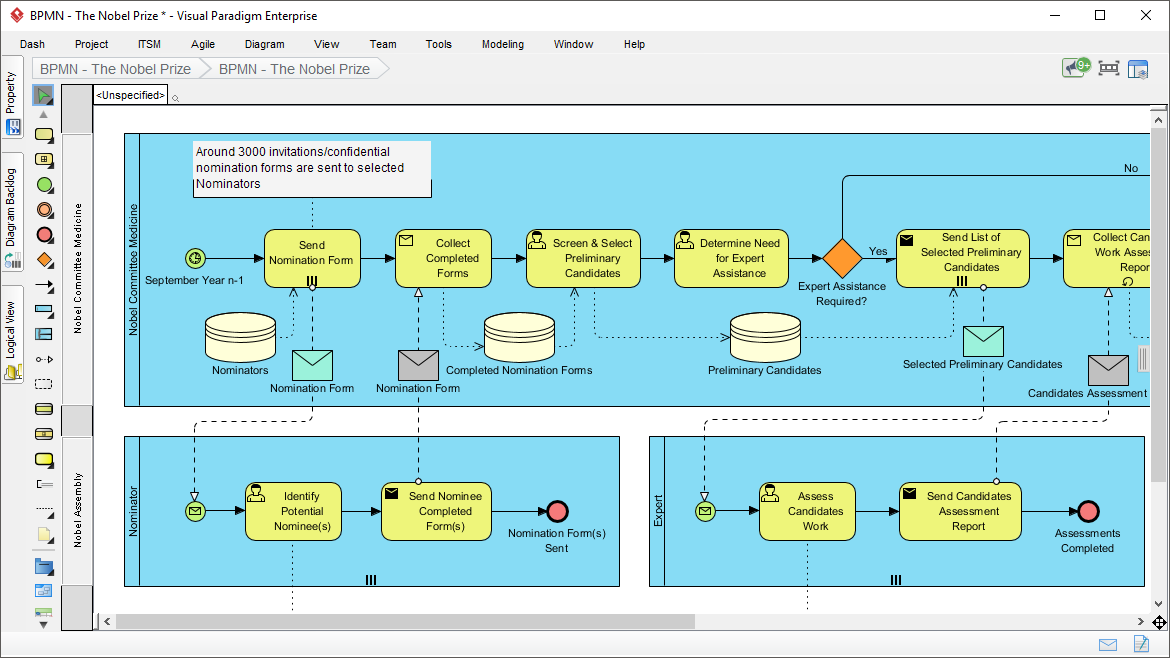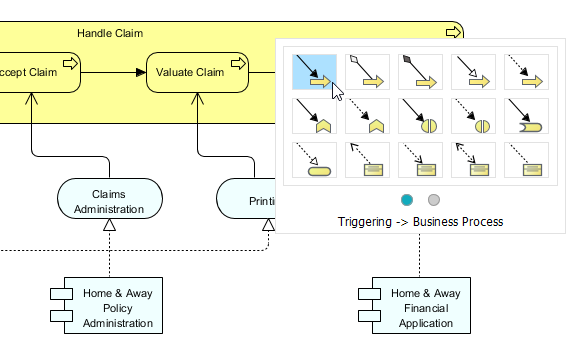ArchiMate vs BPMN: Understanding the Key Differences
ArchiMate and BPMN are both popular modeling standards for business modeling. ArchiMate is an architecture modeling language that provides a visual representation of the structure and organization of an enterprise. On the other hand, BPMN is a business process modeling notation that provides a visual representation of business processes and their flow.
While both ArchiMate and BPMN are useful for modeling businesses, they have distinct differences that make each one better suited for certain use cases. It is important to understand these differences in order to choose the best approach for your needs. In this article, we will compare ArchiMate and BPMN and help you understand the key differences between the two, helping you to make informed decisions about which approach is best for your specific use case.
Understanding ArchiMate
What is ArchiMate?
ArchiMate is a modeling language and methodology used for describing, analyzing, and visualizing enterprise architecture. It provides a comprehensive and consistent way of describing the elements and relationships that make up an enterprise’s information systems, processes, and organizational structure.

Key features and capabilities of ArchiMate
ArchiMate offers a wide range of features and capabilities for modeling and documenting enterprise architecture. Some of the key features include:
- A rich set of modeling elements that cover the full range of enterprise architecture domains, including business, data, application, and technology
- A clear and consistent modeling language that makes it easy to describe and understand the relationships between the different elements in an enterprise architecture
- A flexible and extensible modeling methodology that can be adapted to fit the specific needs of different organizations and projects
Examples of how ArchiMate is used in real-world scenarios
ArchiMate is used by a wide range of organizations for a variety of purposes, including:
- Planning and designing new information systems
- Assessing the impact of changes to existing systems
- Communicating enterprise architecture to stakeholders
- Facilitating alignment between the different domains of an enterprise architecture
- Evaluating the impact of external factors, such as new regulations or market trends, on the enterprise architecture
In each of these scenarios, ArchiMate provides a clear and consistent way of modeling and documenting the elements and relationships that make up the enterprise architecture. This makes it a powerful tool for understanding and improving the overall design of an organization’s information systems and processes.
Understanding BPMN
What is BPMN?
BPMN, or Business Process Model and Notation, is a graphical language that provides a standardized way to visualize and describe business processes. It is a widely used modeling language in the fields of business process management and service-oriented architecture.

Key features and capabilities of BPMN
BPMN is designed to be simple, intuitive, and easy to understand, even for those who are not familiar with modeling languages. The key features and capabilities of BPMN include the ability to:
- Model complex business processes using a wide range of process elements, including activities, gateways, events, and data objects.
- Visualize and describe the flow of activities within a process, including the relationships between activities and the decision-making logic that governs the flow.
- Define process roles and responsibilities, including the participants involved in each activity and their relationships with one another.
- Standardize the representation of business processes across different organizations and domains, ensuring consistency and ease of communication.
Examples of how BPMN is used in real-world scenarios
BPMN is widely used in a range of industries and organizations, from large corporations to small startups. Some examples of how BPMN is used in real-world scenarios include:
- Modeling and improving business processes within an organization, such as HR processes, supply chain processes, or customer service processes.
- Communicating business process requirements and design decisions between stakeholders, such as business analysts, developers, and project managers.
- Documenting and analyzing business processes in preparation for business process automation and digital transformation initiatives.
- Providing a common language and framework for process improvement efforts and continuous improvement programs.
Comparing ArchiMate and BPMN
Similarities between ArchiMate and BPMN
ArchiMate and BPMN have several similarities, even though they serve different purposes. Both ArchiMate and BPMN are modeling languages used to represent business processes, and they can both be used to visualize the flow of processes, activities, and tasks. Additionally, both ArchiMate and BPMN can be used to communicate process models with stakeholders and facilitate collaboration between different departments and teams.
Differences between ArchiMate and BPMN
Purpose
The primary difference between ArchiMate and BPMN is their purpose. ArchiMate is a modeling language used to represent the architecture of an enterprise, while BPMN is used to model business processes. This means that ArchiMate focuses on the overall structure and organization of an enterprise, while BPMN focuses on the specific steps and activities involved in a business process.
Notation
Another key difference between ArchiMate and BPMN is their notation. ArchiMate uses a unique, symbol-based notation that represents different elements of an enterprise architecture, such as business processes, applications, data, and technology. On the other hand, BPMN uses a flowchart-based notation that represents the flow of activities, events, and tasks involved in a business process.
Level of detail
ArchiMate is designed to provide a high-level view of an enterprise architecture, while BPMN provides a more detailed view of business processes. This means that ArchiMate provides a broader and more comprehensive view of an enterprise, while BPMN provides a more focused and detailed view of specific business processes.
User-friendliness
Both ArchiMate and BPMN are designed to be user-friendly and accessible to a wide range of users. However, the level of user-friendliness may vary depending on the level of familiarity with the notation and the specific tool being used. BPMN is generally considered to be more user-friendly than ArchiMate, as it uses a flowchart-based notation that is widely used and recognized.
When to use ArchiMate vs BPMN
Factors to consider
When choosing between ArchiMate and BPMN, there are several factors to consider, such as the level of detail required, the purpose of the modeling, and the target audience. Additionally, it is important to consider the tools and resources available, as well as the level of expertise required to use each modeling language effectively.
Use cases for ArchiMate
ArchiMate is ideal for use in a wide range of scenarios, including enterprise architecture planning and design, strategy development, and business process improvement. ArchiMate can also be used to identify and document the relationships between different elements of an enterprise, such as business processes, applications, data, and technology.
Use cases for BPMN
BPMN is ideal for use in scenarios where a detailed view of business processes is required, such as process improvement, process design and optimization, and process communication and collaboration. BPMN can also be used to model complex business processes that involve multiple tasks, activities, and events.
Visual Paradigm: ArchiMate and BPMN modeler
Visual Paradigm is a comprehensive software design tool that supports modeling in various domains, including ArchiMate and BPMN.
With Visual Paradigm, you can create ArchiMate and BPMN diagrams with ease, leveraging the tool’s intuitive interface, rich visual elements and smart features. The tool provides a range of modeling elements and templates to get started quickly, as well as the ability to customize elements and properties to meet specific needs. The models created in Visual Paradigm can be stored and managed in a centralized repository, making it easy to keep track of changes and collaborate with others.

Conclusion
In this blog, we compared ArchiMate and BPMN, two commonly used tools for modeling business processes. We discussed the definitions of both tools, their key features and capabilities, and real-world examples of how they are used. We also looked at the similarities and differences between ArchiMate and BPMN, including their purpose, notation, level of detail, and user-friendliness.
Final Thoughts
In conclusion, ArchiMate and BPMN are both powerful tools that have their own strengths and weaknesses. While they share some similarities, they are designed to meet different needs and requirements. It is important to understand the differences between ArchiMate and BPMN to determine which tool is best suited for a specific use case.
Recommendation for Which Tool to Use
When deciding between ArchiMate and BPMN, it’s important to consider your specific needs and requirements. For example, if you need a more detailed representation of business processes, ArchiMate might be a better choice. On the other hand, if you are looking for a more user-friendly tool that can be easily understood by stakeholders, BPMN might be a better option. Ultimately, the choice between ArchiMate and BPMN will depend on the complexity of your business processes and the level of detail required to effectively model them.
References
When writing this blog, we relied on the following sources to provide in-depth information on ArchiMate and BPMN:
- ArchiMate website (https://www.archimate.org/)
- BPMN website (https://www.bpmn.org/)
- Gartner’s Magic Quadrant for Business Process Management Suites (https://www.gartner.com/en/documents/3940228)
These sources provided us with the latest information and insights on the capabilities, features, and use cases of ArchiMate and BPMN.
Additional Resources
For those who are interested in learning more about ArchiMate and BPMN, we recommend the following additional resources:
- ArchiMate specification (https://www.opengroup.org/subjectareas/enterprise/archimate)
- BPMN specification (https://www.omg.org/spec/BPMN/)
- ArchiMate tutorials (https://www.youtube.com/results?search_query=archimate+tutorial)
- BPMN tutorials (https://www.youtube.com/results?search_query=bpmn+tutorial)
- ArchiMate and BPMN books (https://www.amazon.com/s?field-keywords=archimate+and+bpmn)

